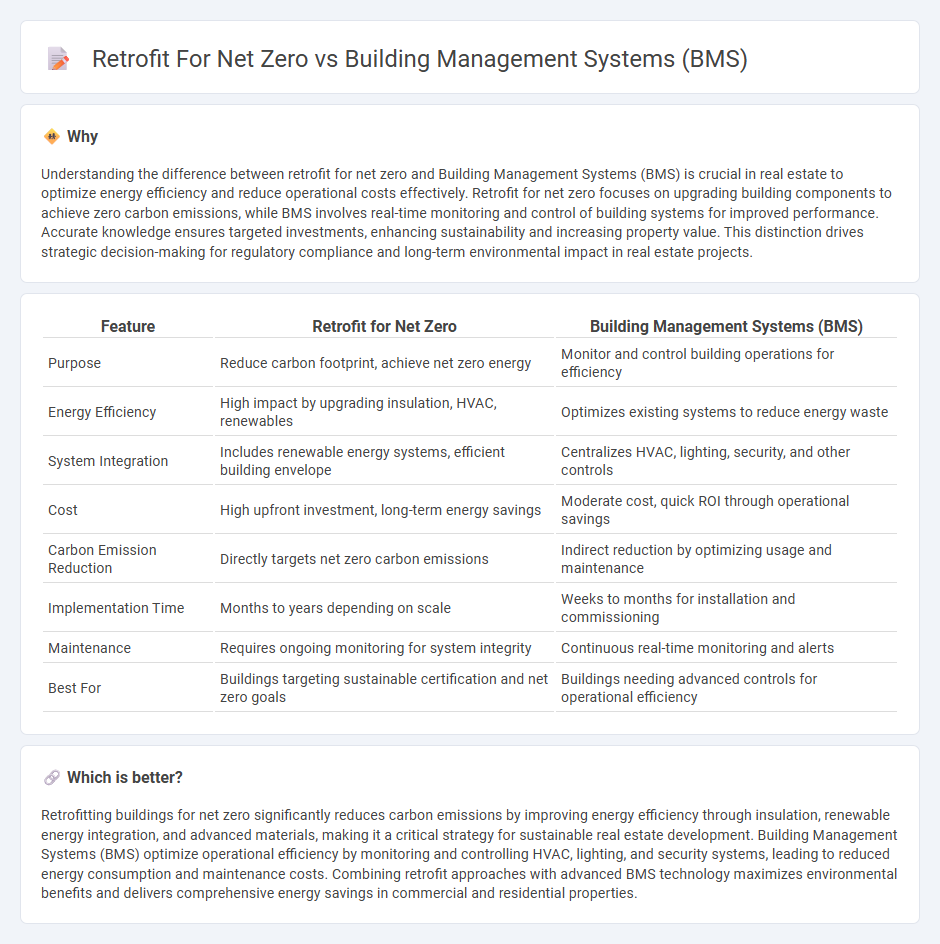
Retrofitting buildings for net zero energy focuses on upgrading insulation, installing renewable energy sources, and enhancing energy efficiency to minimize carbon emissions. Building Management Systems (BMS) optimize real-time energy consumption through automated controls, monitoring HVAC, lighting, and security systems to improve operational efficiency. Explore comprehensive strategies to integrate retrofit solutions with BMS for sustainable real estate development.
Why it is important
Understanding the difference between retrofit for net zero and Building Management Systems (BMS) is crucial in real estate to optimize energy efficiency and reduce operational costs effectively. Retrofit for net zero focuses on upgrading building components to achieve zero carbon emissions, while BMS involves real-time monitoring and control of building systems for improved performance. Accurate knowledge ensures targeted investments, enhancing sustainability and increasing property value. This distinction drives strategic decision-making for regulatory compliance and long-term environmental impact in real estate projects.
Comparison Table
| Feature | Retrofit for Net Zero | Building Management Systems (BMS) |
|---|---|---|
| Purpose | Reduce carbon footprint, achieve net zero energy | Monitor and control building operations for efficiency |
| Energy Efficiency | High impact by upgrading insulation, HVAC, renewables | Optimizes existing systems to reduce energy waste |
| System Integration | Includes renewable energy systems, efficient building envelope | Centralizes HVAC, lighting, security, and other controls |
| Cost | High upfront investment, long-term energy savings | Moderate cost, quick ROI through operational savings |
| Carbon Emission Reduction | Directly targets net zero carbon emissions | Indirect reduction by optimizing usage and maintenance |
| Implementation Time | Months to years depending on scale | Weeks to months for installation and commissioning |
| Maintenance | Requires ongoing monitoring for system integrity | Continuous real-time monitoring and alerts |
| Best For | Buildings targeting sustainable certification and net zero goals | Buildings needing advanced controls for operational efficiency |
Which is better?
Retrofitting buildings for net zero significantly reduces carbon emissions by improving energy efficiency through insulation, renewable energy integration, and advanced materials, making it a critical strategy for sustainable real estate development. Building Management Systems (BMS) optimize operational efficiency by monitoring and controlling HVAC, lighting, and security systems, leading to reduced energy consumption and maintenance costs. Combining retrofit approaches with advanced BMS technology maximizes environmental benefits and delivers comprehensive energy savings in commercial and residential properties.
Connection
Retrofitting for net zero in real estate involves upgrading building infrastructure to drastically reduce energy consumption and carbon emissions, which is effectively managed through advanced Building Management Systems (BMS). BMS optimize energy use by integrating real-time data on heating, ventilation, air conditioning, lighting, and renewable energy sources, ensuring buildings meet net zero targets efficiently. Energy-efficient retrofits combined with intelligent BMS technologies significantly enhance sustainability and operational performance in commercial and residential properties.
Key Terms
Energy Efficiency
Building Management Systems (BMS) enhance energy efficiency by integrating real-time monitoring and automated controls to optimize HVAC, lighting, and energy use in existing and new buildings. Retrofit solutions target upgrading insulation, windows, and renewable energy integration to reduce carbon footprints and achieve net zero goals. Explore detailed strategies and technologies to maximize energy efficiency and reach net zero targets in your building projects.
Automation Integration
Building Management Systems (BMS) enable centralized control of HVAC, lighting, and energy usage, optimizing operational efficiency to support net zero goals. Retrofit solutions integrate automation technologies into existing infrastructures, enhancing energy savings and reducing carbon footprints without extensive rebuilding. Discover how automation integration in BMS and retrofits drives sustainable building performance and accelerates net zero transformations.
Carbon Emissions Reduction
Building Management Systems (BMS) enable real-time monitoring and optimization of energy consumption, significantly reducing carbon emissions in commercial and residential buildings. Retrofit solutions enhance existing infrastructure by upgrading HVAC, lighting, and insulation systems to meet net zero targets, offering substantial long-term emission reductions. Explore detailed strategies to compare BMS and retrofit approaches for effective carbon emissions reduction.
Source and External Links
Smart Building Management System - A Building Management System (BMS) is a computer-based system that controls and monitors a building's mechanical and electrical equipment including ventilation, lighting, power, fire, and security systems to improve efficiency, safety, and sustainability in building operations.
What is a Building Management System (BMS)? - A BMS communicates with a building's equipment to enhance energy performance, maintenance, and occupant comfort by integrating systems like HVAC, lighting, and energy supply for centralized automated control.
What is a building management system? - A BMS is an automated computer system that monitors and manages mechanical, electrical, and safety systems such as air quality, lighting, fire safety, and security to optimize building operations and occupant comfort.
 dowidth.com
dowidth.com